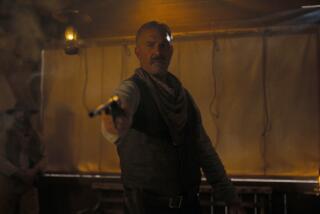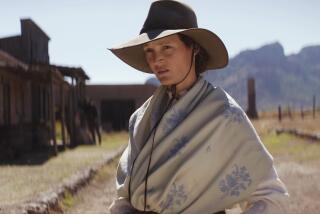Five must-see westerns beyond ‘The Lone Ranger’
It won’t be only Disney executives who are watching the box office returns for “The Lone Ranger” this weekend. Lots of people are wondering whether Johnny Depp and Armie Hammer can ride to the rescue of a genre that was once a staple of American cinema but now has fallen on hard times: the western.
“The western has always been a definitively American art form,” says Jeffrey Richardson, Gamble curator of western history, popular culture and firearms at the Autry National Center of the American West in Griffith Park in Los Angeles. “It’s one that has grown and evolved over time, but unfortunately it has been in decline over the past 50 years.”
The western doesn’t have the same place in the minds of young people that it does for the baby-boomer generation, who grew up on the movies of John Wayne, Gary Cooper and Clint Eastwood, and television series such as “Gunsmoke,” “Bonanza” and “Wagon Train.” The western is an empty word for them, conjuring images of cowboys and campfires but disassociated from the true heart behind them -- the survivalist sentiments and moral lessons.
PHOTOS: Behind-the-scenes Classic Hollywood
Even Richardson, who is 35, says he didn’t grow up on western movies -- and he’s made a career out of the genre.
Still, every few years the western makes a reappearance. There was the remake of the classic “True Grit” (2010), starring Jeff Bridges and Matt Damon, and the more contemporary western “No Country for Old Men” (2007), starring Tommy Lee Jones and Javier Bardem. But neither completely won over young audiences as the former was rated PG-13 and the latter R.
Richardson thinks the revival of “The Lone Ranger” has a shot at change that (although it too is PG-13).
“The marketing might of Disney and Johnny Depp might make this a little different -- hopefully ignite a passion of a much younger audience,” he says.
Not only was the film shot on location in Colorado, New Mexico and Utah, but modern technology adds an entirely new component, especially in comparison to many great western films that weren’t even shot outdoors, Richardson notes.
PHOTOS: ‘The Lone Ranger’ premiere
“Hopefully a movie like ‘The Lone Ranger’ will provide a good combination of live action and CGI -- for a younger audience that expects CGI and an older audience that might think it’s heavy-handed,” he says.
In anticipation of “The Lone Ranger’s” release, Richardson shared his top five western films:
“Unforgiven” (1992) -- This film, directed by and starring Clint Eastwood, follows retired gunslinger William Munny (Eastwood) as he takes one last job after a prostitute is disfigured by cowboys. A darker western, “it really shows the moral and social complexity of the western genre,” says Richardson. “It was one of the few I saw as a kid in the theater. I thought westerns were very simplistic, and this film was so much more than that.”
The film went on to win an Academy Award for best picture and was the third western to do so -- following on the spurs of “Cimarron” (1931) and “Dances With Wolves” (1990).
“High Noon” (1952) -- “It’s the most screened movie by the White House,” says Richardson. It doesn’t conform to the typical action-packed western scenario. “Really it is quite slow and very methodical,” Richardson says. “The build-up and pacing to the climactic action is confined to the ending minutes, but the drama and suspense is quite powerful.”
Gary Cooper plays Will Kane, a longtime marshal in New Mexico who is newly married to Ann (Grace Kelly) and about to turn in his badge when he learns that a man he once arrested is seeking revenge. Kane turns back to help, but the townspeople refuse to assist him, so he must act alone.
“The Wild Bunch” (1969) -- The most violent of the group, this Sam Peckinpah film traces a pack of outlaws on the Texas border who look for one last robbery, as the West is becoming more gentrified all around them. “It showed the excitement of the West, but in somewhat of a more unrelenting style that really showed the consequences of violence,” Richardson says.
“The Searchers” (1956) -- “I would probably lose my job if I didn’t mention at least one John Wayne-John Ford collaboration,” says Richardson. Probably no other actor has starred in more westerns than Wayne, who was known for his rugged, masculine look that made him the perfect cowboy. But in this one, “you really see him as a human and not a caricature. He [Wayne] shows an entire range of emotion,” he says.
“Blazing Saddles” (1974) – No western movie list is complete without this comedic classic. This western satire stars Cleavon Little and Gene Wilder and is directed by Mel Brooks, who also appears in multiple supporting roles. The film is filled with oddities and anachronisms -- such as its black lawman, Sheriff Bart (Little). “It has that heart of absurdity that really skewers the genre in ways that are fun and informative,” says Richardson, especially in the scene where Sheriff Bart holds himself hostage.
For more western films, check out the Autry’s, “What Is a Western?” film series, one Saturday a month at the Wells Fargo Theatre in Griffith Park. More details here.
[For the record, July 5, 5:26 p.m.: A previous version of this post said a prostitute was killed in “Unforgiven.” Though she was the victim of a knife attack that disfigured her face, she was not killed.]
ALSO:
Depp and Verbinski keep upping the dollars, if not the quality
‘The Lone Ranger’ premiere: A long red carpet under a hot sun
James Badge Dale trusts his instincts in ‘Lone Ranger,’ ‘World War Z’
Twitter: @celinecwright
More to Read
The complete guide to home viewing
Get Screen Gab for everything about the TV shows and streaming movies everyone’s talking about.
You may occasionally receive promotional content from the Los Angeles Times.






